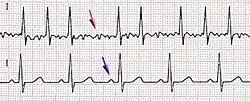Etiology
Cardiologists are unsure exactly what causes holiday heart syndrome. The ingestion of alcohol may slow down the cardiac conduction system, which is an important system for managing the circulatory system. It may also shorten the refractory period of the atrium. Another possibility is that alcohol consumption increases the level of catecholamines, which increased the level of P-waves, and therefore the risk of arrhythmia. Alcohol intake can also lead to a rise in plasma free fatty acids and an increase in the activity of the sympathetic nervous system. [6] [7] An ATP2A2 enhancer known as JNK2 may play a role. Alcohol may activate it, which can affect other proteins therefore increasing the risk of arrhythmia. [8] Heavy consumption of alcohol may lead to an increased level of ethanol and metabolites such as acetaldehyde inside of the body. [9] [10] All of these factors can contribute to arrhythmia. [11]
Drinking large quantities of alcohol or caffeine, [12] [13] [14] eating fatty foods with salt, [15] heightened levels of stress, [16] [17] and dehydration are all risk factors for the development of this syndrome. HHS can appear in people who do not usually drink. Often these people who rarely drink may engage in an episode of heavy alcohol consumption and develop it as soon as they drink, others contract it 12–36 hours following the time of intoxication. [18] Usually patients with this disorder lack any family history or previous clinical evidence of cardiological problems. [4] Studies suggest moderate drinking (5-7 drinks per week) may not increase the risk of atrial fibrillation compared to abstinence; however, consumption beyond this range is associated with a substantial increase in the risk of HHS, further supporting the greater risk that binge drinking poses to the development of this condition. [19]
Symptoms and complications
The most common symptoms people with HHS have are heart palpitations and arrhythmia. [20] People usually present with atrial fibrillation; however, other forms of arrhythmia may be developed, such as atrial tachycardia, premature ventricular contraction, and atrial flutter. Patients with HHS also frequently report precordial pain, sweating, anxiety, shortness of breath, and syncope. Strokes and cardiac arrest can also occur in people with this syndrome. [4] People with holiday heart syndrome have a heightened risk of dilated cardiomyopathy, rhabdomyolysis, and acute kidney injury [21] and increased atrial vulnerability to external electrical stimulus under the influence. [22]
The heightened level of acetaldehyde this syndrome causes can result in mitochondrial dysfunction, valvular disease, oxidative damage, cell death, lowered effects of cardioprotective molecules, and an altered calcium transport and protein synthesis system. [4] If left untreated, it can result in thrombosis, pneumonia, cirrhosis, and heart failure. [5] [18] For most patients with HHS the syndrome only lasts 24 hours. However for 26% of people with this syndrome, they reexperience an episode of it within the next year. To treat patients with this condition cardioversion or other treatments for arrhythmia are used. [4]
This page is based on this
Wikipedia article Text is available under the
CC BY-SA 4.0 license; additional terms may apply.
Images, videos and audio are available under their respective licenses.
